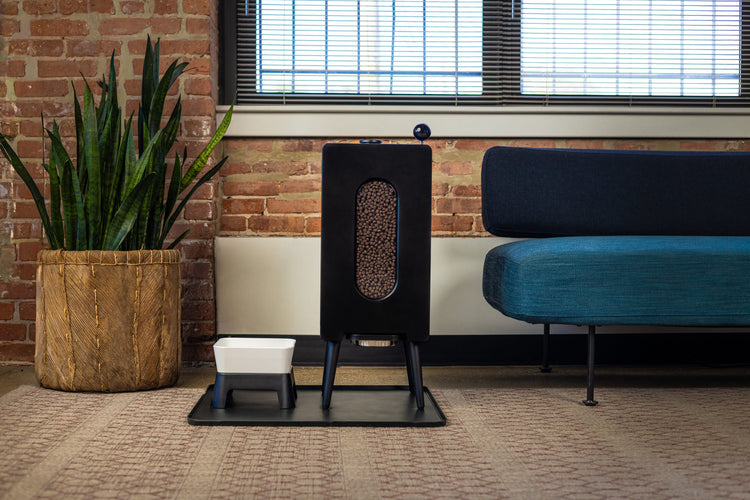Can Canned Dog Food Cause Diarrhea? Understanding the Link Between Wet Food and Your Dog’s Digestive Health
- Houndsy
Table of Contents
- Introduction
- Why Does Dog Diarrhea Happen After Eating Canned Food?
- Differentiating Between Wet Food and Other Causes of Diarrhea
- How to Prevent Diarrhea When Feeding Canned Dog Food
- When Is Wet Food Appropriate—or Not?
- Practical Case Example: Transitioning Max from Dry to Wet Food
- How Houndsy Enhances Every Feeding Ritual
- Summary: Can Canned Dog Food Cause Diarrhea? The Takeaway
- FAQ
Introduction
Imagine this: you’ve just switched your dog to a new can of delicious wet food, expecting a happy, satisfied pet—but instead, you’re greeted by sudden bouts of diarrhea and an unsettled stomach. As a dedicated dog owner, these unexpected digestive troubles can be concerning. After all, you want the best for your furry friend—an enjoyable meal experience that supports their health and well-being. But, can canned dog food cause diarrhea? And if so, why?
In recent years, wet dog food has surged in popularity, prized for its palatability, moisture content, and the natural ingredients that often mirror a dog’s ancestral diet. Yet, there’s also plenty of chatter about whether switching to canned food could lead to upsetting your pet’s digestion. In this blog, we’ll dive into these questions head-on, unraveling the causes behind digestive upsets linked to canned food, how to transition safely, and what to watch for with your dog’s diet.
By the end of this post, you'll understand the factors that can make canned dog food cause diarrhea, practical ways to feed your pooch without digestive drama, and how thoughtfully designed products like the Houndsy Kibble Dispenser can simplify your feeding routine while maintaining your dog’s health. Before we dive in—have you noticed any changes in your dog’s stool or appetite after introducing wet food? Let’s explore what’s going on.
Why Does Dog Diarrhea Happen After Eating Canned Food?
The Digestive Challenge of Dietary Changes
First off, it’s important to recognize one of the most common reasons diarrhea occurs after switching to canned dog food: the change itself. Dog digestive systems are sensitive to abrupt shifts in diet composition. Canned dog food typically differs substantially from dry kibble in moisture, texture, protein levels, and ingredient types, which can lead the gut to react.
Sudden changes can cause digestive upset through:
- Altered gut microbiota: Dogs’ intestines harbor a complex community of bacteria optimized to digest their usual diet. A sudden swap can disrupt this balance, causing loose stools.
- Higher moisture content: Wet food contains approximately 70-80% moisture, markedly more than dry kibble. This change can speed transit time of food through the intestines, resulting in softer stools.
- Different nutrient profiles: Canned foods often feature higher protein or fat content, which can overwhelm sensitive digestive tracts, especially in dogs not accustomed to rich diets.
Veterinary experts commonly recommend gradually transitioning over several days to weeks—for example, mixing 25% new wet food with 75% old food initially, then steadily increasing the new food’s proportion to minimize gastrointestinal upset.
Ingredient Sensitivities and Allergies
Another key reason canned food can cause diarrhea stems from ingredient intolerance or food allergies. Sometimes specific proteins (e.g., beef, chicken, or fish), grains, or additives in certain canned formulas do not agree with individual dogs.
For instance, some dogs have sensitivities to common fillers like corn, wheat, or soy, or even to artificial preservatives and flavorings used by less reputable brands. Such ingredients can provoke inflammatory responses in the gut lining, leading to diarrhea or chronic digestive issues.
Spoilage and Hygiene Concerns
Let’s talk about a less obvious but crucial factor: food safety and storage. Wet dog food, once opened, is highly perishable. If left exposed in a bowl or improperly stored, canned food can develop bacteria or mold that disrupt your dog’s digestive tract. Eating spoiled or contaminated food is a fast track to diarrhea—and worse, possible infections.
Dogs who graze throughout the day on wet food left in their dish may be more susceptible to this. Hence, feeding manageable portions and promptly refrigerating leftovers is essential to keep your dog’s meals safe and fresh.
Differentiating Between Wet Food and Other Causes of Diarrhea
Sometimes, diarrhea coinciding with canned dog food isn’t caused by the food itself. Here’s what else could be responsible:
- Stress and environmental changes: Dogs experiencing anxiety, boarding, or travel may have gut disturbances.
- Illness or infections: Parasites, bacterial infections, or viral illnesses can cause diarrhea independently of diet.
- Toxin ingestion: Dogs are notorious for scavenging, and they may eat harmful substances.
- Underlying health conditions: Pancreatitis, inflammatory bowel disease, or allergies may manifest as diarrhea.
If diarrhea is severe, chronic, or accompanied by other symptoms like vomiting, lethargy, or dehydration, a prompt visit to your veterinarian is critical.
How to Prevent Diarrhea When Feeding Canned Dog Food
Smart Food Selection
Choosing high-quality canned food is foundational. Look for products listing a named meat as the first ingredient (e.g., chicken, lamb, or fish), without excessive fillers, artificial colors, or preservatives. Grain-free or limited-ingredient options might benefit dogs with food sensitivities.
Often, brands with transparent sourcing and testing provide better nutritional consistency.
Gradual Food Transition Routine
As mentioned earlier, change your dog’s diet gradually over 5 to 7 days or more. Here is a practical feeding transition plan:
| Days | Old Food % | New (Canned) Food % |
|---|---|---|
| 1–2 | 75% | 25% |
| 3–4 | 50% | 50% |
| 5–6 | 25% | 75% |
| 7+ | 0% | 100% |
This slows digestive adaptation, minimizing upset.
Monitor Portion Sizes and Feeding Frequency
Canned food generally has a denser calorie content and higher moisture, so feeding guidelines on cans may differ from dry food. Overfeeding is a common cause of loose stools. Use a precise portion control tool—preferably one made to deliver consistent meals like the elegant and ergonomic Houndsy Kibble Dispenser. This dispenser ensures accurate portions and simplifies mealtime, which helps prevent accidental overeating or spoilage.
Ensure Freshness and Proper Storage
Store unopened canned food in a cool, dry place. Once opened, refrigerate leftovers in airtight containers and serve within 3-5 days. Avoid leaving wet food in bowls for extended periods.
Support Digestive Health with Supplements
Adding probiotics or fiber such as plain canned pumpkin can ease stool consistency and soothe the gut. Probiotics encourage beneficial bacteria to flourish, aiding digestion.
When Is Wet Food Appropriate—or Not?
Benefits Suited for Certain Dogs
Wet dog food can be especially beneficial for:
- Puppies: Easier to chew and digest, appealing flavors encourage eating.
- Seniors: Softer texture suits aging teeth; added moisture benefits hydration.
- Fussy eaters or sick dogs: Enhanced aromas and textures can stimulate appetite.
- Weight management: Lower carbohydrate content can help maintain lean weight.
When to Use with Caution
Dogs prone to digestive sensitivity, chronic pancreatitis, or particular food allergies may need diet adjustments and veterinarian guidance to avoid problems.
Moreover, relying solely on wet food without routine dental care may promote tartar buildup, since canned food lacks the abrasive quality of dry kibble that naturally cleans teeth.
Practical Case Example: Transitioning Max from Dry to Wet Food
Max, a 5-year-old Labrador, was eating dry kibble exclusively but recently developed a picky appetite. His owner wanted to introduce wet food to boost palatability.
- Day 1-3: Mixed 25% canned food with 75% dry.
- Day 4-6: Increased to 50% canned food but noticed loose stools on day 5.
- Adjustment: Slowed transition to 25% increments every 3 days.
- Added: Plain pumpkin to meals and probiotics.
- Outcome: After two weeks, Max digested the new canned food well, stools normalized, and appetite improved.
This example highlights the importance of a careful approach, patience, and digestive support.
How Houndsy Enhances Every Feeding Ritual
At Houndsy, we understand that feeding time is more than just a routine—it’s a moment to celebrate your dog’s health and happiness. Our flagship Houndsy Kibble Dispenser is designed for discerning pet parents who value both style and convenience. With perfect portion control, an ergonomic standing-height crank, and sleek mid-century modern design, it eliminates the mess and guesswork associated with feeding.
Its large capacity (25–30 lbs), BPA-free liner for freshness, and auto-locking mechanism ensure your dog’s food stays pristine and safe from accidental spills—even from the most curious pups or toddling toddlers in the home. This means less stress, less mess, and more quality time with your furry friend.
By streamlining feeding and portioning, the Houndsy dispenser can also help maintain consistent dietary habits—minimizing digestive issues such as diarrhea that can arise from irregular feeding or overfeeding.
Summary: Can Canned Dog Food Cause Diarrhea? The Takeaway
Canned dog food can indeed cause diarrhea, but not as a universal rule. The primary causes usually boil down to rapid dietary change, ingredient sensitivities, food spoilage, or underlying health factors. With a mindful approach—informed food choices, gradual transitions, proper storage, and attentive monitoring—you can minimize the risk of digestive upset and enjoy the many benefits wet food offers.
For dog owners ready to combine convenience, style, and balanced feeding routines without the hassle, exploring the Houndsy Kibble Dispenser is a smart move. Feeding your dog should lift the day, not cloud it with worry.
How have you managed feeding changes with your dog? Have you experienced diarrhea after switching diets? Let’s keep the conversation going and support each other in creating joyful, healthy feeding moments.
FAQ
Q1: How long does it usually take for a dog to adjust to canned food without diarrhea?
It typically takes about 7 to 14 days for a dog’s digestive system to adapt if you transition gradually. Rushing the change increases the risk of diarrhea.
Q2: Is canned dog food more likely to cause diarrhea than dry kibble?
Not inherently. Both wet and dry foods can cause diarrhea if introduced too quickly or if ingredients don’t agree with the dog. The key is quality and gradual introduction.
Q3: Can I mix canned and dry dog food safely?
Yes, mixing canned and dry dog food is common, but it should be balanced carefully in terms of calories and transition time to avoid digestive upset.
Q4: What should I do if my dog develops diarrhea after eating canned food?
Stop feeding the canned food temporarily, offer a bland diet like boiled chicken and rice, ensure hydration, and consult your vet if diarrhea persists beyond 24-48 hours or worsens.
Q5: How does the Houndsy Kibble Dispenser help with digestive health?
By providing consistent, measured portions and easy feeding routines, the Houndsy dispenser helps avoid overfeeding or sudden dietary changes that often contribute to digestive issues like diarrhea.
Ready to simplify feeding while enhancing your dog’s health? Check out the Houndsy Kibble Dispenser today and make every meal a smooth, stylish experience.












